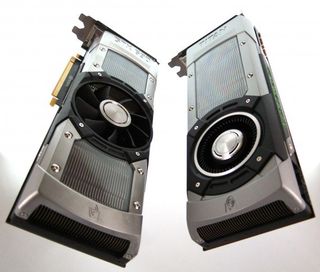Nvidia unveil the GTX Titan. An elegant weapon for a more civilised age.

Anyone remember Cray unveiling their new Titan supercomputer at the tail-end of last year? Y'know, that vast data-munching machine housing 18688 of Nvidia's Tesla K20 graphics cards, each of which go for around £2500/$3500. I remember looking down mournfully at the GTX 680 in my test rig and thinking “wouldn't it be nice to have just one of those graphics cards?”
Well, now you can.
Nvidia has re-engineered the GK110 GPU that sits at the heart of the professional Tesla cards and stuck it in a gaming-focused desktop boards. Thus, the GTX Titan is born.

It's a beautifully engineered card, all magnesium-effect aluminium and perspex shielding, much like the dual-GPU GTX 690 we saw last year. But it's what's under the hood that really counts.
That GK110 chip is vastly superior to the GK104 GPU we've come to know and love in the GTX 680. It's got a huge number of CUDA cores in that massive GPU, a total of 2688 compared with 1536 in the GK104.
That means it's got performance to burn.
Right now I'm bound from giving out any benchmark figures until I can bring you the review on Thursday, but all I'll say is that when I plugged my three GTX Titan cards in SLI into Unigine's new Valley benchmark I almost wept.
PC Gamer Newsletter
Sign up to get the best content of the week, and great gaming deals, as picked by the editors.
This is the fastest single-GPU card ever made.
But that doesn't make it the fastest overall graphics card. The GTX 690 and the AMD Radeon HD 7990 also make a good fist of gaming performance for similar money.
But the Titan is an elegant solution that doesn't rely on the vagaries of multi-GPU software support to run. You wont need to wait for SLI or CrossFire profiles, your games will just run.

Obviously this performance isn't going to come cheap, with the GTX Titan proposed to tip up around the same sort of price as the GTX 690. That's around £700/$1000.
That's a huge amount of cash and Nvidia is now calling this sector the ultra-enthusiast.
It's a tricky one when you're trying to consider this pricey little card in terms of value for money, but when you think this is essentially a £2500 card for less than a grand it's going to make all those amateur 3D renderers sit up and take notice too. There is a vast amount of double-precision processing power available, over one teraflop in each GPU.
And hell, you can even get this one to run games too.

But the GTX Titan is at once a beautiful and terrible thing to behold.
This, right here, is likely the pinnacle of graphics excellence for the next couple of years, probably until Nvidia release another Titan based on the Maxwell-powered GM110 GPU.
I chatted with Nvidia about this card a few weeks back and they admitted the GTX 700 series will not be as fast as this. And for all us geeky gaming types who like to herald the next “fastest graphics card ever” it's going to be a long wait.
Still, I desperately want to keep one of these amazingly powerful cards sat in my test rig right now. I'm sure Nvidia wouldn't miss it...
Any questions?

Dave has been gaming since the days of Zaxxon and Lady Bug on the Colecovision, and code books for the Commodore Vic 20 (Death Race 2000!). He built his first gaming PC at the tender age of 16, and finally finished bug-fixing the Cyrix-based system around a year later. When he dropped it out of the window. He first started writing for Official PlayStation Magazine and Xbox World many decades ago, then moved onto PC Format full-time, then PC Gamer, TechRadar, and T3 among others. Now he's back, writing about the nightmarish graphics card market, CPUs with more cores than sense, gaming laptops hotter than the sun, and SSDs more capacious than a Cybertruck.
Most Popular





